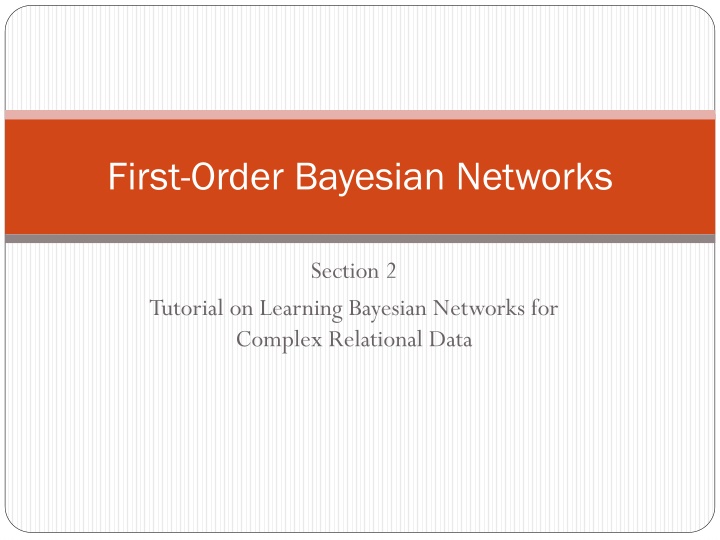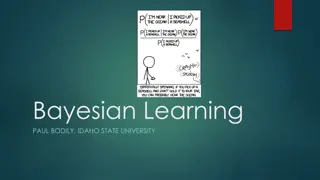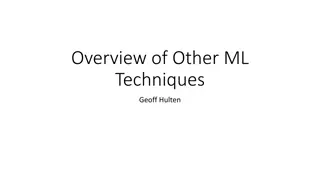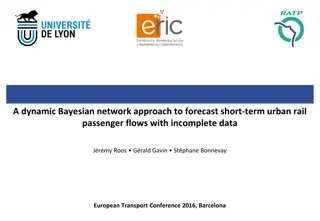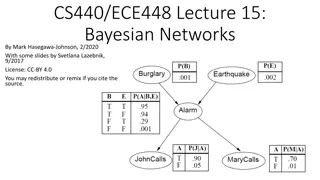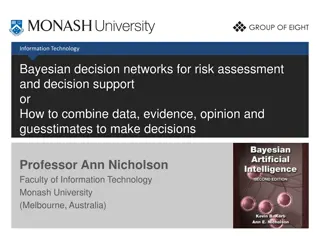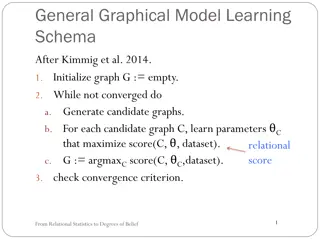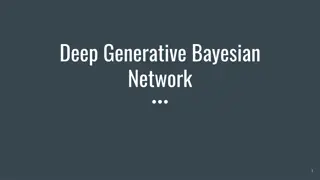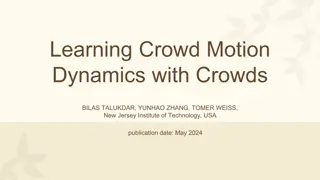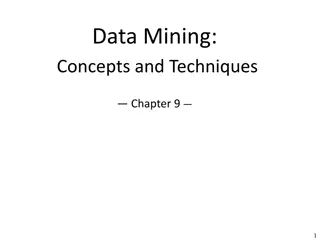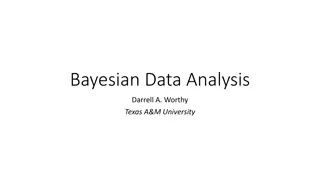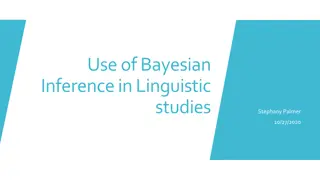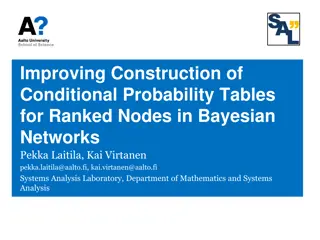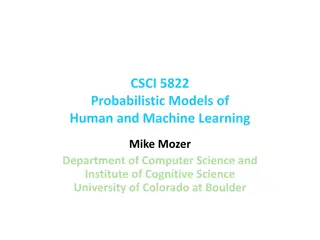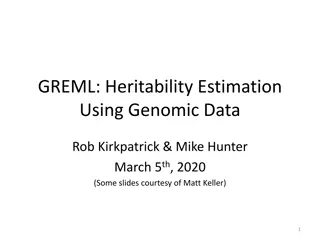Tutorial on Learning Bayesian Networks for Complex Relational Data
This tutorial delves into the realm of Bayesian networks for complex relational data, exploring concepts like first-order Bayesian networks, learning models, extending network models, relational data and logic, and first-order logic terms. Discover how Bayesian networks support probabilistic frequency queries, represent joint distributions of random variables, and visualize correlations. Explore the interplay between relational random variables, first-order terms, and probabilistic semantics in building complex models.
Download Presentation

Please find below an Image/Link to download the presentation.
The content on the website is provided AS IS for your information and personal use only. It may not be sold, licensed, or shared on other websites without obtaining consent from the author.If you encounter any issues during the download, it is possible that the publisher has removed the file from their server.
You are allowed to download the files provided on this website for personal or commercial use, subject to the condition that they are used lawfully. All files are the property of their respective owners.
The content on the website is provided AS IS for your information and personal use only. It may not be sold, licensed, or shared on other websites without obtaining consent from the author.
E N D
Presentation Transcript
First-Order Bayesian Networks Section 2 Tutorial on Learning Bayesian Networks for Complex Relational Data
Bayesian Networks for i.i.d. data Directed Acyclic Graph, where nodes = random variables Parameters = probability of child node given parent nodes Represents joint distribution of random variables Supports probabilistic frequency queries, visualizes correlations 2 Learning Bayesian Networks for Complex Relational Data
Bayesian Network Demo 3 Learning Bayesian Networks for Complex Relational Data
Extending Bayesian Network Models for Relational Data Need to extend the following concepts: relational random variable joint distribution of relational random variables 4 Learning Bayesian Networks for Complex Relational Data
Relational Data and Logic Lise Getoor David Poole Stuart Russsell Stephen Kleene Poole, D. (2003), First-order probabilistic inference, 'IJCAI . Getoor, L. & Grant, J. (2006), 'PRL: A probabilistic relational language', Machine Learning 62(1-2), 7-31. Russell, S. & Norvig, P. (2010), Artificial Intelligence: A Modern Approach, Prentice Hall. Stephen Kleene, (1952). Introduction to Metamathematics.
First-Order Logic An expressive formalism for specifying relational conditions. database theory relational learning First-Order Logic Query language Pattern Language Kimmig, A.; Mihalkova, L. & Getoor, L. (2014), 'Lifted graphical models: a survey', Machine Learning, 1--45. 6
First-Order Logic: Terms A constant refers to an individual Fargo A first-order variable refers to a class of individuals Movie refers to Movies Terms A constant or first-order variable is a term. The result of applying a functor to a term is a term. contains first-order variables? first-order term e.g. salary(Actor, Movie) ground term e.g. salary(UmaThurman, Fargo) Stephen Kleene, (1952). Introduction to Metamathematics. North Holland. 7
Relational Random Variables First-order random variable = First-order term + probabilistic semantics (Wang et al. 2008) Ground random variable = ground term + probabilistic semantics (Kimmig et al. 2014) Both complex terms and complex random variables are built by function application Statistics Apply function to random variable(s) new random variable Logic Apply function to term(s) new term Wang, D. Z.; Michelakis, E.; Garofalakis, M. & Hellerstein, J. M. (2008), BayesStore: managing large, uncertain data repositories with probabilistic graphical models, in , Proceedings VLDB Endowment, , pp. 340--351. Kimmig, A.; Mihalkova, L. & Getoor, L. (2014), 'Lifted graphical models: a survey', Machine Learning, 1 45. 8
Formulas A (conjunctive) formula is a joint assignment term1 = value1,...,termn=valuen e.g., ActsIn(Actor, Movie) = T, gender(Actor) = W A ground formula contains only constants e.g., ActsIn(UmaThurman, KillBill) = T, gender(UmaThurman) = W 9
Network View: Formula = Template A conjunctive formula can be viewed as specifying a type of subgraph in the Gaifman graph e.g. the pattern ActsIn(Actor, Movie) = T, gender(Actor) = W occurs twice gender = Man country = U.S. gender = Man country = U.S. gender = Woman country = U.S. gender =Woman country = U.S. $500,000 $5,000,000 $2,000,000 runtime = 111 min country = U.S. runtime = 98 min country = U.S. 10 Learning Bayesian Networks for Complex Relational Data
Notation We use standard notation for relational random variables. Concept First-order random variable Ground-random variable k-th value of random variable Parents of node i j-th configuration of node i s parents paij Notation X, Xi X* xk, xik Pai 11 Learning Bayesian Networks for Complex Relational Data
Relational Frequencies Probabilistic Semantics for First-Order Random Variables Learning Bayesian Networks for Complex Relational Data
Applications of Relational Frequency Modelling Knowledge women users like movies with women actors Strategic increase SAT requirements to decrease student attrition Query Optimization (Getoor, Taskar, Koller 2001) Class-level queries support optimal evaluation order for SQL query discovery/ rule learning Planning selectivity estimation Getoor, Lise, Taskar, Benjamin, and Koller, Daphne. Selectivity estimation using probabilistic models. ACM SIGMOD Record, 30(2):461 472, 2001. 13
Relational Frequencies Database probability of a first-order formula = number of satisfying instantiations/ number of possible instantiations Examples: PD(gender(Actor) = W) = 2/4 PD(gender(Actor) = W, ActsIn(Actor,Movie) = T) = 2/8 14 Learning Bayesian Networks for Complex Relational Data
The Grounding Table P(gender(Actor) = W, ActsIn(Actor,Movie) = T) = 2/8 frequency = #of rows where the formula is true/# of all rows FO Variable Single data table that correctly represents relational joint frequencies Schulte (2011), Riedel, Yao, McCallum (2013) Actor Movie gender(Actor) ActsIn(Actor,Movie ) M M W W M M W W F F F T T F F T Brad_Pitt Brad_Pitt Lucy_Liu Lucy_Liu Steve_Buscemi Fargo Steve_Buscemi Kill_Bill Uma_Thurman Fargo Uma_Thurman Kill_Bill Fargo Kill_Bill Fargo Kill_Bill 15
Random Selection Semantics First-Order Variable Random Variable Prob Actor Movie gender(Actor) M M W W M M W W ActsIn(Actor,Movie) F F F T T F F T 1/8 1/8 1/8 1/8 1/8 1/8 1/8 1/8 Brad_Pitt Brad_Pitt Lucy_Liu Lucy_Liu Steve_Buscemi Fargo Steve_Buscemi Kill_Bill Uma_Thurman Fargo Uma_Thurman Kill_Bill Fargo Kill_Bill Fargo Kill_Bill P(Movie = Fargo, Actor=Brad_Pitt) =1/2 x 1/4 = 1/8 16 Halpern, J. Y. (1990), 'An analysis of first-order logics of probability', Artificial Intelligence 46(3), 311--350.
Random Selection Semantics Population Actors Population variables First-Order Random Variables Actor Random Selection from Actors. P(Actor = brad_pitt) = 1/4 gender(Actor) Gender of selected actor. P(gender(Actor) = W) = 1/2 ActsIn(Actor,Movie) = T if selected actor appears in selected movie, F otherwise P(ActsIn(Actor,Movie) = T) = 3/8 Movies Movie Random Selection from Movies. P(Movie = Fargo) = 1/2 Drama(Movie) Is the selected movie a drama? P(Drama(Movie)=T) = 1/2 17
Bayesian Network Models for Relational Statistics Statistical-Relational Models (SRMs) Random Selection Semantics for Bayesian Networks Learning Bayesian Networks for Complex Relational Data
Bayesian networks for relational data A first-order Bayesian network is a Bayesian network whose nodes are first-order terms (Wang et al. 2008) AKA parametrized Bayesian network (Poole 2003, Kimmig et al. 2014) gender(A) Drama(M) ActsIn(A,M) Wang, D. Z.; Michelakis, E.; Garofalakis, M. & Hellerstein, J. M. (2008), BayesStore: managing large, uncertain data repositories with probabilistic graphical models, in , VLDB Endowment, , pp. 340--351. Kimmig, A.; Mihalkova, L. & Getoor, L. (2014), 'Lifted graphical models: a survey', Machine Learning, 1--45. 19
Random Selection Semantics for First-Order Bayesian Networks P(gender(Actor) = W, ActsIn(Actor,Movie) = T, Drama(Movie) = F) = 2/8 if we randomly select an actor and a movie, the probability is 2/8 that the actor appears in the movie, the actor is a woman, and the movie is a drama gender(A) Drama(M) ActsIn(A,M) 20 Learning Bayesian Networks for Complex Relational Data
Real-World Examples To illustrate frequency semantics, learn and evaluate on the training set ground truth about frequencies We discuss generalization later 21 Learning Bayesian Networks for Complex Relational Data
IMDb Data Format data with two relationships 22 Learning Bayesian Networks for Complex Relational Data
Learned Bayes Net for Full IMDB 23 Learning Bayesian Networks for Complex Relational Data
Learned Bayes Net for IMDb With only 1 relationship HasRated(User,Movie). 24 Learning Bayesian Networks for Complex Relational Data
Bayes Net Query 25 Learning Bayesian Networks for Complex Relational Data
Data Query Num Movies Num Users Num Movie-User Pairs 3883 6039 3883 x 6039 = 23449437 movie-user pairs with action movie, woman user Action(Movie) = T, HasRated(User,Movie) = T, gender(User) = W 66642 66642/23449437= 0.0028 Frequency More Examples in spreadsheet on website 26 Learning Bayesian Networks for Complex Relational Data
Mondial Data Format 27 Learning Bayesian Networks for Complex Relational Data
Learned Bayes Net for Mondial 28 Learning Bayesian Networks for Complex Relational Data
Bayes Net query 29 Learning Bayesian Networks for Complex Relational Data
Data Query Number of Europe-Europe Borders Number of *-Europe Borders P(continent(country1) = Europe|Borders(country1,country2) = T, continent(country2=Europe)) 156 166 156/166= 93.98% BN was learned with frequency smoothing (Laplace correction) More Examples in spreadsheet on website 30 Learning Bayesian Networks for Complex Relational Data
Bayesian Networks are Excellent Estimators of Relational Frequencies Queries Randomly Generated Example: P(gender(A) = W|ActsIn(A,M) = true, Drama(M)=T)? Learn Bayesian network and test on entire database as in Getoor et al. 2001 BN? trend? line? BN? BN? trend? line? BN? BN? trend? line? BN? BN? trend? line? BN? 1? 1? 1? 1? 0.9? 0.9? 0.9? 0.9? Bayes? Net? Inference? Bayes? Net? Inference? Bayes? Net? Inference? 0.8? Bayes? Net? Inference? 0.8? 0.8? 0.8? 0.7? 0.7? 0.7? 0.7? 0.6? 0.6? 0.6? 0.6? 0.5? 0.5? 0.5? 0.5? 0.4? 0.4? 0.4? 0.4? MovieLens? Average? difference? ? 0.006? +-? 0.008? Mondial? Average? difference? ? 0.009? +-? 0.007? Hepa Average? difference? ? 0.008? +-? 0.01? s? Financial? Average? difference? 0.009? +-? 0.016? 0.3? 0.3? 0.3? 0.3? 0.2? 0.2? 0.2? 0.2? 0.1? 0.1? 0.1? 0.1? 0? 0? 0? 0? 0? 0.1? 0.2? 0.3? 0.4? 0.5? 0.6? 0.7? 0.8? 0.9? 1? 0? 0.1? 0.2? 0.3? 0.4? 0.5? 0.6? 0.7? 0.8? 0.9? 1? 0? 0.1? 0.2? 0.3? 0.4? 0.5? 0.6? 0.7? 0.8? 0.9? 1? 0? 0.1? 0.2? 0.3? 0.4? 0.5? 0.6? 0.7? 0.8? 0.9? 1? True? Database? Frequencies? True? Database? Frequencies? True? Database? Frequencies? True? Database? Frequencies? Schulte, O.; Khosravi, H.; Kirkpatrick, A.; Gao, T. & Zhu, Y. (2014), 'Modelling Relational Statistics With Bayes Nets', Machine Learning 94, 105-125. Getoor, L.; Taskar, B. & Koller, D. (2001), 'Selectivity estimation using probabilistic models', ACM SIGMOD Record 30(2), 461 472. 31
Summary: Relational Frequencies The frequency of a conjunctive formula in a possible world = number of satisfying instantiations/ number of possible instantiations First-order Bayesian networks represent frequencies of conjunctive formulas very well visualize correlations answer frequency queries using BN inference, not data access 32 Learning Bayesian Networks for Complex Relational Data
